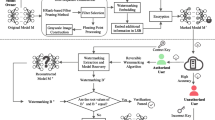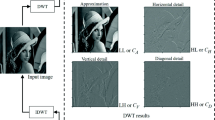Abstract
In this paper, we consider a tamper-resistant control system aiming at protecting the knowledge of the controller from attackers. In this control system, the controller operates normally only for a limited number of time-varying specific states; otherwise, it outputs an incorrect value. We propose to realize the tamper-resistant controller by employing a neural network and time-varying quantization. Furthermore, we make it possible for only one trained neural network to be used for all quantization based on the local approximation linearity of the trained neural network. Without this approach, the neural network needs to be trained for every possible quantization, which leads to huge computation. We provide simulations to demonstrate the security and feasibility of the proposed method.





Similar content being viewed by others
References
Sandberg H, Amin S, Johansson KH (2015) Cyberphysical security in networked control systems: an introduction to the issue. IEEE Control Syst Mag 35(1):20–23
Kaustubh I, Steve H, Gonzalo S, Kyzer D, Chidambaram A (2018) Understanding session border controllers: comprehensive guide to designing, deploying, troubleshooting, and maintaining Cisco Unified Border Element (CUBE) Solutions. Cisco Press, Indianapolis
Kogiso K, Fujita T (2015) Cyber-security enhancement of networked control systems using homomorphic encryption. In: IEEE conference on decision and control, pp 6836–6843, Osaka
Rivest RL, Shamir A, Adleman L (1978) A method for obtaining digital signatures and public-key cryptosystem. Commun ACM 21(2):120–126
ElGamal T (1985) A public key cryptosystem and a signature scheme based on discrete logarithms. IEEE Trans Inf Theory 31(4):469–472
Kim J, Lee C, Shim H et al (2016) Encrypting controller using fully homomorphic encryption for security of cyber-physical systems. IFAC PapersOnLine 49(22):175–180
Takayama T, Ariizumi R, Azuma S, Asai T, Tanemura M (2019) Tamper resistant controller with neural network. In: The 63rd annual conference of the institute of systems, control and information engineers, Osaka (in Japanese)
Ohtsuka T, Zanma T, Liu KZ (2014) State estimation in quantized feedback control system. In: 2014 IEEE 13th international workshop on advanced motion control, pp 746–751, Japan
Almakhles D, Swain AK, Nasiri A et al (2017) An adaptive two-level quantizer for networked control systems. IEEE Trans Control Syst Technol 259(3):1084–1091
Zhao Q, Xu H, Jagannathan S (2015) Optimal control of uncertain quantized linear discretetime systems. Int J Adapt Control Signal Process 29(3):325–345
Roger WB, Daniel L (2000) Quantized feedback stabilization of linear systems. IEEE Trans Autom Control 45(7):1279–1289
Isakov M, Bu L, Cheng H et al (2018) Preventing neural network model exfiltration in machine learning hardware accelerators. In: 2018 Asian hardware oriented security and trust symposium, pp 62–67, Hong Kong
Agarap A F (2018) Deep learning using rectified linear units. arXiv:1803.08375
Ramachandran P, Zoph B, Le QV (2017) Searching for activation functions. arXiv:1710.05941
Acknowledgements
This work was supported by Grant-in-Aid for Scientific Research (B) #17H03280 from the Ministry of Education, Culture, Sports, Science and Technology of Japan.
Author information
Authors and Affiliations
Corresponding author
Additional information
Publisher's Note
Springer Nature remains neutral with regard to jurisdictional claims in published maps and institutional affiliations.
This work was presented in part at the 3rd International Symposium on Swarm Behavior and Bio-Inspired Robotics (Okinawa, Japan, November 20–22, 2019).
A Proof
A Proof
1.1 A.1 Proof of the security condition of \(V_t\)
Let A be an arbitrary non-empty open set in \(\chi\). To prove the security condition, we need to show that
If Eq. (16) is satisfied, then by defining A as \(A=N_{\epsilon }(q_t)\backslash \{q_t\}\) for some \(q_t\in V_t\) and \(\epsilon >0\), where \(=N_{\epsilon }(q_t)\) is the open ball centered at \(q_t\) with radius \(\epsilon\), it can be concluded that there are some \(q_{t'}\in V_{t'}\) that satisfy \(0< \Vert q_t-q_{t'}\Vert < \epsilon\) almost surely.
Proof
As \(\bigcup _{t=0}^{\infty } V_t\) is a countable set, we can enumerate the elements of \(\bigcup _{t=0}^{\infty } V_t\) as \(x_1,\ x_2,\ \cdots\), where \(x_i\ (i=1, 2, \ldots )\) can be regarded as independent samples from the uniform distribution in \(\chi\). Because of the assumption of independent sampling, we have
Since A is an non-empty open set, \(P(x \in A) > 0\). Therefore,
This completes the proof. \(\square\)
1.2 A.2 Proof that \(\{\cos (t) | t\in \mathbb {N} \}\) is dense in \([-1,1]\)
To prove that \(\{\cos (t) | t\in \mathbb {N} \}\) is dense in \([-1,1]\), it is sufficient to show that for any \(\epsilon >0\) and any \(\beta \in [0, 2 \pi )\), there exist \(n,k\in \mathbb {N}\) that satisfy
where \(x=(\beta / k +2\pi )\in \mathbb {R}\).
Proof
From Dirichlet’s approximation theorem: Given any real number \(\theta\) and any positive integer N, there exist integers h and k with \(0<k\le N\) such that
Therefore, for an \(N>1 / \epsilon\), there exist natural numbers n and k with \(0<k\le N\) such that
which completes the proof. \(\square\)
About this article
Cite this article
Xu, F., Ariizumi, R., Azuma, Si. et al. Tamper-resistant controller using neural network and time-varying quantization. Artif Life Robotics 25, 596–602 (2020). https://doi.org/10.1007/s10015-020-00647-x
Received:
Accepted:
Published:
Issue Date:
DOI: https://doi.org/10.1007/s10015-020-00647-x




